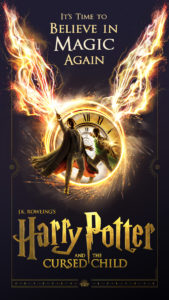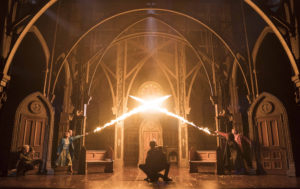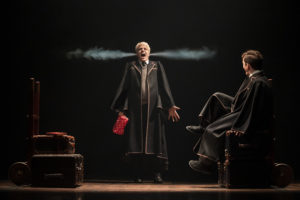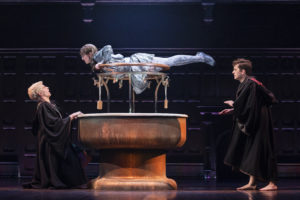NEW YORK CITY — One of the most successful franchises of all time, Harry Potter, is now a Broadway fixture, with Harry Potter and the Cursed Child. Originally conceived as a two-night event, the show was condensed into a one-night, 3½-hour play after the COVID-19 pandemic. Spending so much time in the Harry Potter universe must be a delight for devoted fans, but anyone else who sees it will find Cursed Child to be a wonderous spectacle wrapped in a tedious story.

In Harry Potter and the Cursed Child, the title character is all grown up and sending his third child, Albus Severus Potter, to Hogwarts. The young boy soon befriends Scorpius Malfoy, the son of Harry’s schoolyard nemesis, Draco Malfoy. The two are soon involved in a sprawling, byzantine plot that jeopardizes the wizarding world.
The script (written by Jack Thorne, based on a story by J. K. Rowling, Jack Thorne, and John Tiffany) is essentially two stories that function almost independently. That means twice the exposition and twice the plot to get through, and most scenes consist of characters delivering information solely so that they can get to the next scene. The script skimps on character development and instead relies heavily on the audience’s knowledge of the characters from the books and movies. Anyone who does not know — or does not remember — events and people like the Battle of Hogwarts, the Marauder’s Map, flue powder, Dolores Umbridge, or Neville Longbottom will be baffled by Cursed Child.
Where Cursed Child excels is in its unmatched spectacle. Under director John Tiffany, Cursed Child features jaw-dropping stagecraft in nearly every scene. The mixture of movement, performance, and stage wizardry (pun intended) makes Cursed Child one of the most memorable experiences that people can have in a theater. The production’s magic supervisor and arranger, Martin Lowe, creates dozens of illusions that astonish without fail and bring Rowling’s magical world to life. It is thrilling to watch wizards duel with the incendio spell or see objects levitate in response to the wingardium leviosa spell.

Tiffany also excels in the more traditional direction. The theatrical movement (from movement director Steven Hoggett) for the scene transitions and the shifting staircases of Hogwarts were not flashy, but they were beautiful components that showed the value of the fundamentals of staging. The smaller scenes, such as the fight between Harry and Albus in the latter’s bedroom, were timed perfectly to maximize the emotional impact. Unfortunately, the quiet, beautiful moments were too few in Cursed Child, and often the staging was so overwhelming that it obscured the plot. The final train scene is an example of this deficiency; with the flashing lights, blaring soundscape, and magic special effects all happening at once, it was hard to absorb what was happening to the characters or care about their plight.

Every design for Cursed Child is among the finest that can be found on stage. Neil Austin’s lighting design is practically its own character in the play, simulating everything from fireballs to the growing darkness of an army of evil wizards. Christine Jones‘s set was incredibly versatile; the mix of industrial, medieval, and natural motifs on the arches and stairways allowed the same pieces to be used for multiple locations without any staleness setting in. Costume designer Katrina Lindsay mixed the magical and the mundane to recreate Harry Potter’s magical realm. Lindsay’s greatest costuming triumph was the wizard robes for the evil wizards in the middle of the play, which were more tightly cropped around the body and featured a backpiece that resembled a lizard’s scaling, giving the actors wearing those robes a creepy, malevolent appearance.
With all the phenomenal stagecraft in Cursed Child, though, the actors get lost. The script devotes about 10 or 15 minutes of character development, and most lines could be shifted to another character without anyone noticing. Being the utmost professionals, the cast does fine work with the material they have. But they labor in the shadow of the special effects and a script that reduces most to spewing out plot points, and few audience members will leave the theater talking about the performances they saw.

As Albus Potter, James Romney plays a teenager who is burdened with the problems that many teens face: unpopularity, resentment towards parents, etc. Romney gives an eager, energetic performance that stays likeable throughout the show. As Harry Potter, William Rhem, Jr. is a stabilizing presence in the production. Rhem portrays Harry as a loving but frustrated father, and the dads taking their children to the play will feel like Rhem’s performance is eerily familiar. Stealing the show is Michaela Cannon as Moaning Myrtle. Cannon plays the character briefly, but her shrieking laugh and gleeful taunting brought made her scenes come alive (ironic, because the character is dead).
Brady Dalton Richards is fully committed to the role of Scorpius Malfoy. But he is trapped by the director’s and playwright’s decision to make Scorpius as unlike his father Draco as possible. Scorpius is sniveling and eccentric, and the character is not an enjoyable one to spend three hours with. This makes the friendship between Scorpius and Albus into the most unbelievable aspect of a show that features wizards, magic, and enchanted paintings. When the script finally gives Richards some meat (a scene in which Scorpius tells off Albus for being selfishly focused on this own problems), the actor is captivating. However, his dialogue delivery in other scenes too rushed, and the sloppy diction made parts of the story difficult to follow.
Harry Potter and the Cursed Child is a show for diehard Harry Potter fans. Yet, anyone who sees it will be blown away by the designs and stagecraft. Underneath the spectacle, though, is a script that is still an hour too long and that treats actors like automatons and not artists capable of creating rich, nuanced performances. Cursed Child is a wonderful technical accomplishment, and it is worth appreciating for that reason alone.
[box]The Broadway production of Harry Potter and the Cursed Child plays Tuesdays through Sundays at 7 PM, Wednesdays and Saturdays at 1 PM, and Sundays at 2 PM at the Lyric Theatre (214 West 43rd Street, New York City). For more information, visit broadway.harrypottertheplay.com/.[/box]
